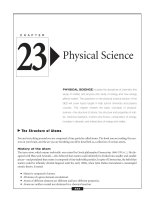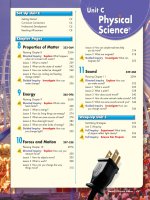4 15 motion (physical science)
Bạn đang xem bản rút gọn của tài liệu. Xem và tải ngay bản đầy đủ của tài liệu tại đây (2.72 MB, 10 trang )
Genre
Nonfiction
Comprehension Skill
Sequence
Text Features
•
•
•
•
Captions
Labels
Call Outs
Glossary
Science Content
Motion
Scott Foresman Science 4.15
ISBN 0-328-13902-5
ì<(sk$m)=bdjacg< +^-Ä-U-Ä-U
Vocabulary
force
frame of reference
friction
gravity
kinetic energy
potential energy
relative motion
speed
velocity
work
What did you learn?
1. What is acceleration?
2. If two teams playing tug-of-war are
pulling on the rope with the same force,
what happens? Why?
3. How do mass and distance affect gravity?
4.
by Christian
Adding Downey
wax to the
bottom of a sled helps reduce friction.
Explain how this is possible. Use details
from the book to support your answer.
5.
Picture Credits
Every effort has been made to secure permission and provide appropriate credit for photographic material.
The publisher deeply regrets any omission and pledges to correct errors called to its attention in subsequent editions.
Photo locators denoted as follows: Top (T), Center (C), Bottom (B), Left (L), Right (R), Background (Bkgd).
2 Maximilian Weinzierl/Alamy Images; 5 Getty Images; 13 David Young-Wolff/PhotoEdit.
Unless otherwise acknowledged, all photographs are the copyright © of Dorling Kindersley, a division of Pearson.
ISBN: 0-328-13902-5
Copyright © Pearson Education, Inc. All Rights Reserved. Printed in the United States of America.
This publication is protected by Copyright, and permission should be obtained from the publisher prior to any
prohibited reproduction, storage in a retrieval system, or transmission in any form by any means, electronic,
mechanical, photocopying, recording, or likewise. For information regarding permission(s), write to
Permissions Department, Scott Foresman, 1900 East Lake Avenue, Glenview, Illinois 60025.
3 4 5 6 7 8 9 10 V010 13 12 11 10 09 08 07 06 05
Sequence Think of at least one object
whose energy can change from potential
to kinetic energy and back again. Explain
when it has kinetic energy and when it
has potential energy.
How Objects Move
A child runs to catch the school bus. A leaf falls
from a tree. These things are moving. Objects can move
in many ways. Some objects move in straight lines.
You may walk down the street in a straight line. If you
drop a ball, it falls to the ground in a straight line.
Some objects move in a curved path. People riding
on a spinning carousel go around in circles. The Moon’s
path around Earth is curved.
Objects can also move back and forth. If you push
a swing in the playground, it moves back and forth.
There are many different ways to move. There are also
many ways to observe and measure motion.
2
The riders on this giant swing
move in a curved path.
How can you tell if something is moving or
standing still? You can compare objects to find out.
Relative motion is the change in one object’s position
compared to another object’s position. If you
are in an airplane above a big city, you can see the
buildings below you. They may seem to be moving.
But, you know that the buildings are not moving.
You are. If you stand still and a dog runs past you,
then the dog is the moving object.
3
From the cyclist’s point of
view, the crowd is moving.
From the crowd’s point of
view, the cyclist is moving.
An airplane accelerates when
it takes off. Its speed increases.
Speed and Velocity
Knowing What Is Moving
By comparing objects, it is possible to figure out
what moves and what does not. It also depends on
your frame of reference, or the objects you use to
detect motion. Look at the cyclist above. To the cyclist,
the bicycle he is riding does not seem to be moving.
The bicycle is his frame of reference. But the people in
the crowd see both the cyclist and the bicycle moving.
4
Speed and velocity are two measurements of motion.
Speed is the rate at which an object changes position.
You can find an object’s average speed by dividing the
distance the object moved by the total time spent moving.
If a plane traveled 1,800 kilometers in two hours, then its
average speed was 900 kilometers per hour.
Velocity is a measure of the speed and direction an
object is moving. North, south, left, and right are some
direction words. As an airplane takes off from the ground,
it rises up into the sky. If it starts to move faster or make
a turn, its acceleration changes. Acceleration is any
change in the speed or direction of an object’s motion.
Acceleration can be speeding up or slowing down.
5
The rope is not moving because
the combined forces on both
sides of the rope are balanced.
Force and Motion
Force is a push or pull. Force can set in motion an
object that is not moving. It can also make a moving
object change direction, stop, slow down, or speed up.
Some forces take effect on contact. That means
these forces must touch an object to have an effect on it.
Hitting a ball with a bat is a contact force. The bat must
touch the ball to make the ball move.
Other forces take effect from a distance. These forces
do not have to touch an object to have an effect on it.
The force of gravity on Earth pulls objects to Earth
without touching them.
If you push or pull an object, you change its motion
and position. How much the motion and position change
depends on the strength of the push or pull. The harder you
hit a ball with a bat, the farther and faster the ball will fly.
6
Combined Forces
Forces can be combined in different ways. If you
pull on a rope, the force of that pull will move the rope
in your direction. If you play tug-of-war with friends
and both sides pull on the rope with equal amounts of
force, both forces work against each other. The forces
are combined but balanced. The rope does not move
in either direction.
Not all forces are balanced. Suppose more people
are pulling on one side of the rope than on the other.
They will pull on the rope with more force than the
people on the other side. The rope will move toward
the side using more force.
7
Even after the athlete releases the ball,
her body continues to move forward.
This is because of inertia.
The surface of snow is
very smooth so it has little
friction. This makes
snow slippery—
perfect for sledding!
Friction
Motion and Force
Inertia is the resistance an object has to any change
in its motion. Suppose you are riding in the bumper cars
at an amusement park. What happens when you hit the
brakes too fast or bump into another car? Your bumper
car stops short, but your body continues to move
forward. Your body has forward inertia, which keeps you
moving after the car has stopped. The same thing happens
if you trip while running. Your feet stop when they hit
something, but the rest of your body continues moving
in the direction it was going. You may even lose your
balance or begin to fall forward. The body’s resistance to
the sudden stop is inertia. The more mass an object has,
the more force is needed to change its direction.
8
If you rub your hands
together quickly, what happens?
Your hands grow warm. This warmth is
caused by friction, a force that acts when two
surfaces rub together. Friction changes depending
on the surfaces of the two objects in contact. Objects
with smooth surfaces have less friction than objects
with rough surfaces. Friction also changes depending
on how hard the surfaces are pressed together.
If you ride down a snowy hill on a sled, you can
go very fast. What would happen if more weight
were added to the sled? The friction would increase.
By adding weight, more friction is created because the
sled is pressing harder against the snow. Friction can
also be decreased. Smoother surfaces have less friction.
If you waxed the bottom of the sled, the friction would
be reduced. The sled would move more easily.
9
Force, Mass,
And Energy
Gravity is the force that pulls objects
toward each other. The force of gravity
between objects depends on their mass and
their distance from each other. Objects with
more mass have greater forces of gravity.
If you throw a ball in the air, Earth pulls
the ball back down. Why doesn’t the ball
pull Earth up? Earth has much more mass
than the ball has. This means it has much
stronger gravity than the ball. Gravity
gets weaker over a distance.
Gravity affects an object’s weight.
Mass is the amount of material in an
object. Weight measures gravity’s
effect on an object’s mass. The force
of gravity can cause an object’s weight
to change. An object weighs more
on Earth than it does on the Moon
because Earth’s gravity is stronger.
Unless mass is added to or removed
from the object, its mass is the same.
If you throw a ball upward, gravity
causes it to fall back down to Earth.
10
How to Measure Force
One way to measure force is with
a spring scale. You can hang an object
from the hook at the bottom of a spring
scale. This causes the spring to stretch.
The weight of the object determines
how much the spring stretches. A heavier
object has more force. A stronger force will
stretch the spring more. The scale shows
the measurement of the object’s force.
Force is measured in units called
newtons. It takes the force of about
one newton to lift a small apple.
The newton was named after Sir Isaac
Newton, a scientist who made important
discoveries about both force and motion.
A spring scale is measuring
the force of an apple.
11
At the top of the slide, the
boy has potential energy
because he is about to move.
This tennis ball has kinetic energy
because it is in motion.
Motion and Energy
The ability to move something is known as work.
Energy is required to do work.
Kinetic energy is the energy of motion. Everything
that moves has kinetic energy. A tennis ball flying across
a court looks much different from an airplane flying
through the sky. What do they have in common? Both
have kinetic energy. The plane has more kinetic energy
than the tennis ball has. Objects with greater mass and
faster speeds have more kinetic energy. Objects with
less mass and slower speeds have less kinetic energy.
12
What do a stretched-out rubber band and a child at
the top of a slide have in common? Both have potential
energy. Potential energy is stored energy. Even though
the rubber band and the child are not yet moving, both
are ready to do so. They can release their stored energy at
any time. Once they move, their potential energy changes
to kinetic energy. It is no longer stored.
13
When the swing
reaches its highest
point, the boy has
potential energy.
While on the swing,
the boy’s energy
is constantly
changing.
While in motion,
the boy has
kinetic energy.
All around you, everyday objects are in motion.
Changing Energy
The amount of energy an object has cannot change.
However, the kind of energy can change. Objects can
switch back and forth from kinetic to potential energy.
Think of moving back and forth on a swing. As you
move upward on the swing, you have kinetic energy.
At the top of the swing’s path, your kinetic energy
changes into potential energy. As you begin to move
again on the swing, the potential energy changes to
kinetic energy.
14
Motion can be affected by forces acting upon it.
Forces can act on an object from direct contact or from
a distance. Friction and gravity can cause changes in
an object’s motion. Energy can be kinetic or potential,
depending on an object’s movement and position.
When motion changes, energy is always required.
Look at the objects around you. Notice what is
moving. Notice what is fixed in place. Do you know
what is making the objects move? Motion and energy
play a big part in everyday life. Without them, we
wouldn’t go anywhere!
15
Vocabulary
Glossary
force
frame of reference
force
a push or pull
friction
gravity
frame
of
the point of view from which you
kinetic
energy
reference
detect motion
potential energy
relative motion
friction
a force that acts when two surfaces
speed
rub together
velocity
work
gravity
a force that pulls objects toward each other
kinetic
energy
the energy of motion
potential
energy
stored kinetic energy
relative
motion
the change in one object’s position compared
to another object’s position
Picture Credits
Every effort has been made to secure permission and provide appropriate credit for photographic material.
The publisher deeply regrets any omission and pledges to correct errors called to its attention in subsequent editions.
speed
the rate at which an object changes
position
Photo locators denoted as follows: Top (T), Center (C), Bottom (B), Left (L), Right (R), Background (Bkgd).
2 Maximilian Weinzierl/Alamy Images; 5 Getty Images; 13 David Young-Wolff/PhotoEdit.
velocity
the measure of the speed and direction
an object is moving
work
the ability to move something
Unless otherwise acknowledged, all photographs are the copyright © of Dorling Kindersley, a division of Pearson.
ISBN: 0-328-13902-5
Copyright © Pearson Education, Inc. All Rights Reserved. Printed in the United States of America.
This publication is protected by Copyright, and permission should be obtained from the publisher prior to any
prohibited reproduction, storage in a retrieval system, or transmission in any form by any means, electronic,
mechanical, photocopying, recording, or likewise. For information regarding permission(s), write to
Permissions Department, Scott Foresman, 1900 East Lake Avenue, Glenview, Illinois 60025.
3 4 5 6 7 8 9 10 V010 13 12 11 10 09 08 07 06 05
16
What did you learn?
1. What is acceleration?
2. If two teams playing tug-of-war are
pulling on the rope with the same force,
what happens? Why?
3. How do mass and distance affect gravity?
4.
Adding wax to the
bottom of a sled helps reduce friction.
Explain how this is possible. Use details
from the book to support your answer.
5.
Sequence Think of at least one object
whose energy can change from potential
to kinetic energy and back again. Explain
when it has kinetic energy and when it
has potential energy.









